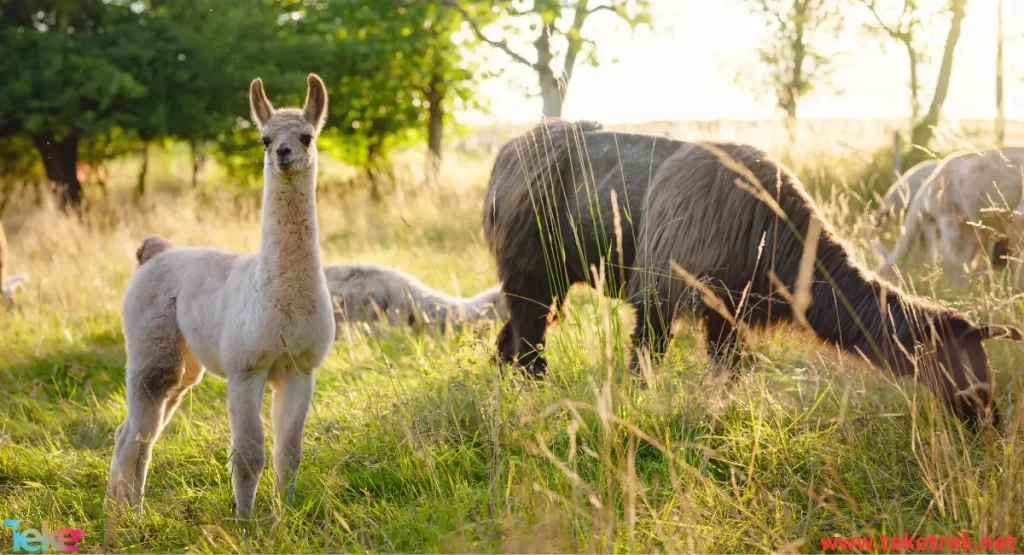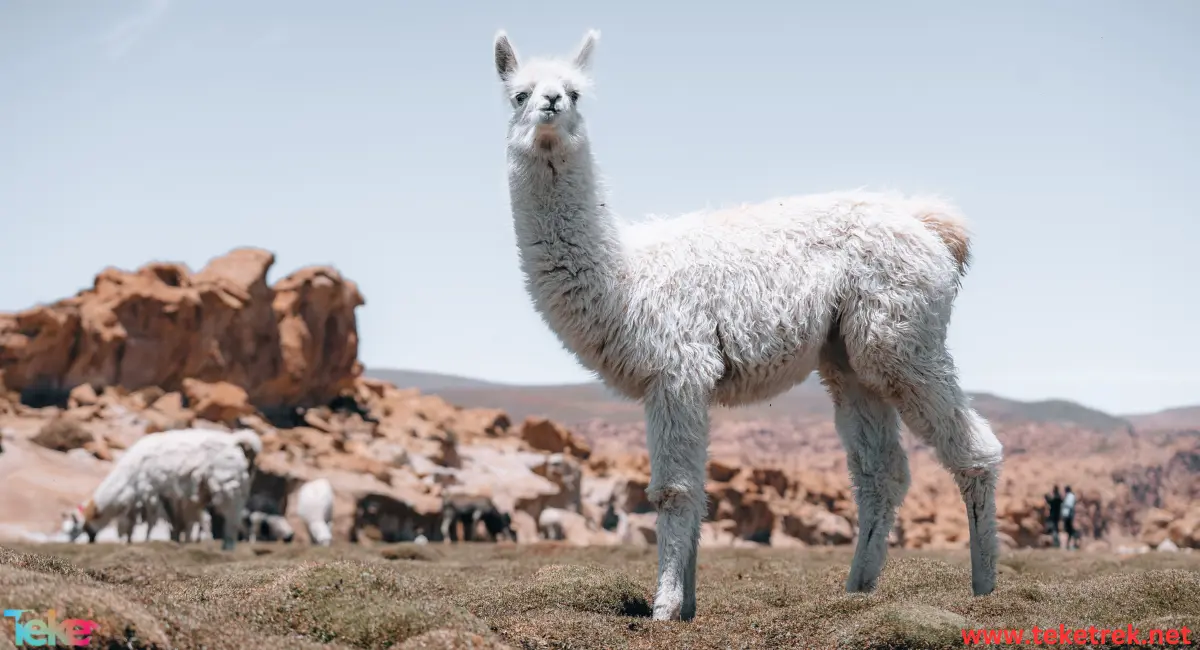The llama is an animal belonging to the camel family, is considered one of the most adaptable mammals to harsh conditions in the Andes Mountains of South America. It is characterized by its unique appearance and has been valuable and significant in South American culture since ancient times.
They are primarily raised for use in agriculture and transportation. They are also popular as domesticated animals and hold great cultural value. below in Teke Trek we discove more about it.

The llama appearance and characteristics
The scientific name for the llama is “Lama Glama”, it is vertebrate animals:
- It is characterized by its long neck, slightly curved long ears, lack of a hump on its back, and a short tail.
- It has dense and long wool, with a soft inner layer that can be used in handicrafts and clothing. The coarse outer hair is used for making rugs, wall hangings, and ropes. The fibers come in various colors ranging from brown to white, black or gray, and dark brown. Their wool contains a small amount of lanolin.
- Known for their calm and friendly demeanor, llamas possess the ability to carry heavy loads through rugged terrain. They are social animals and live in herds.
- It can learn simple tasks after several repetitions. Adult llamas can reach a height of 1.7 to 1.8 meters and weigh between 130 to 272 kilograms. Adult males weigh about 94.74 kilograms, while females can reach around 102.27 kilograms.
- It typically live between 15 and 25 years, with some exceeding 30 years. They have narrow feet, more separated toes than camels, and a distinct plantar pad for each foot.
- Although not ruminants or pseudo-ruminants, It has a complex three-chambered stomach that allows them to digest low-quality food. The compartments enable fermentation of tough food, followed by regurgitation and re-chewing.
- Llamas are known for their ability to carry loads of up to 90 kilograms and walk steadily in the mountains, covering distances exceeding 30 kilometers per day. If they feel the load is too heavy or they are tired, llamas may lie down and refuse to move.
- When sensing a threat or pressure, llamas defend themselves by spitting foul-smelling saliva in the faces of their enemies.
Llama food
Llamas are Herbivorous animals, it feed on a variety of fodder, including straw and dry forage such as clover, corn, and oats, in addition to grass and weeds. Commercial feeds specifically designed for animals can also be added to provide the necessary nutritional balance for their growth and health. The nutritional needs of llamas vary with different stages of their growth and activity levels, with young llamas requiring more nutrients for the development of their smaller digestive system.
Llamas can survive for several weeks without water, compensating for it by consuming green plants that provide the hydration they need.
Llama behavior
- Llamas are often curious and driven to explore their surroundings. They can be friendly and affectionate with humans, but they also exhibit certain natural behaviors as reactions to stress or fear, such as spitting or kicking as a means of self-defense.
- In general, llamas spit as a defense mechanism or to express tension and irritation. Spitting can be a reaction to maintain distance from individuals or animals that the llama feels stressed around. It may also serve as a means of communication with other llamas in the herd, used to confirm social hierarchy or convey a message.
- The more provoked a llama feels, the more material it will try to draw from each of the three stomach compartments for spitting purposes.
- When feeling annoyed or threatened, llamas flatten their ears backward, while raised ears express happiness or curiosity.
Reproduction of Llamas
The lama is a mammal animal that reproduces by giving birth and breastfeeds its young, where:
- The female becomes ready for reproduction at around 12 months of age, while males become sexually mature at approximately 3 years old.
- The gestation period lasts for 11.5 months (350 days).
- Females give birth to their offspring, taking special care such as gentle humming and singing to the newborns instead of licking them due to the unique nature of the llama’s tongue, which does not extend outward extensively.
Llamas and their protection from influenza
Researchers discovered that they have unique antibodies called “nanobodies,” which are much smaller than human antibodies. These nanobodies have the ability to affect certain types of viruses, including coronaviruses such as MERS and SARS-CoV-2, the virus responsible for COVID-19.
Researchers are currently working to understand how these alpaca-derived nanobodies can be used to develop potential treatments or cures against these viruses, thus contributing to the fight against infectious diseases.
Types of llamas
There are several species of mammals in the camelid group, known as Camelidae, including the following members of the Camelidae family:
1. Llama (Lama Glama):
Domesticated llamas are commonly used as pack animals and are bred for their wool. They are utilized in Andean cultures for various purposes such as carrying goods and providing meat.
2. (Guanaco – Lama guanicoe):
Guanacos live in the wild and closely resemble llamas in appearance. They are considered wild animals and are found in the Andes Mountain regions. The guanaco is listed as threatened with extinction. It has a uniform light brown color and white on the underside.
3. (Vicuña – Vicugna vicugna):
Similar to the guanaco but smaller and slenderer, the vicuña has a shorter head. It also lives in the wild, inhabiting high-altitude mountainous regions near permanent snow in Peru, southern Ecuador, and central Bolivia. The vicuña’s wool is highly prized as one of the finest in the world due to its extreme softness and desirability in textiles. However, the quantity produced by these animals is limited.
4. Alpaca (Vicugna pacos):
Alpacas are bred for their soft wool, which is used in the textile industry. They primarily inhabit the Andes Mountains.

FAQ
- Why is llama famous?
Because it is used as a source of wool and meat.
- Where is the llama from?
Llamas live in the Andes Mountains of South America, especially Peru and Bolivia.
- Is llama a sheep or camel?
Llama is small camel.
- What is the origin of the llama?
Among the fossil record, the llama lived in North America, then migrated to the South, and quickly became extinct with the last ice age that occurred in North America.
- What are the characteristics of a llama?
The llama is a mammal from the camelid family that lives in herds. It is distinguished by the fact that when someone bothers it, it spits in his face.
In conclusion, despite their camel-like appearance, the llamas possess unique characteristics and capabilities that make them valuable to the inhabitants of the Andes Mountains, serving as a source of food or for transporting goods in challenging mountainous environments.





